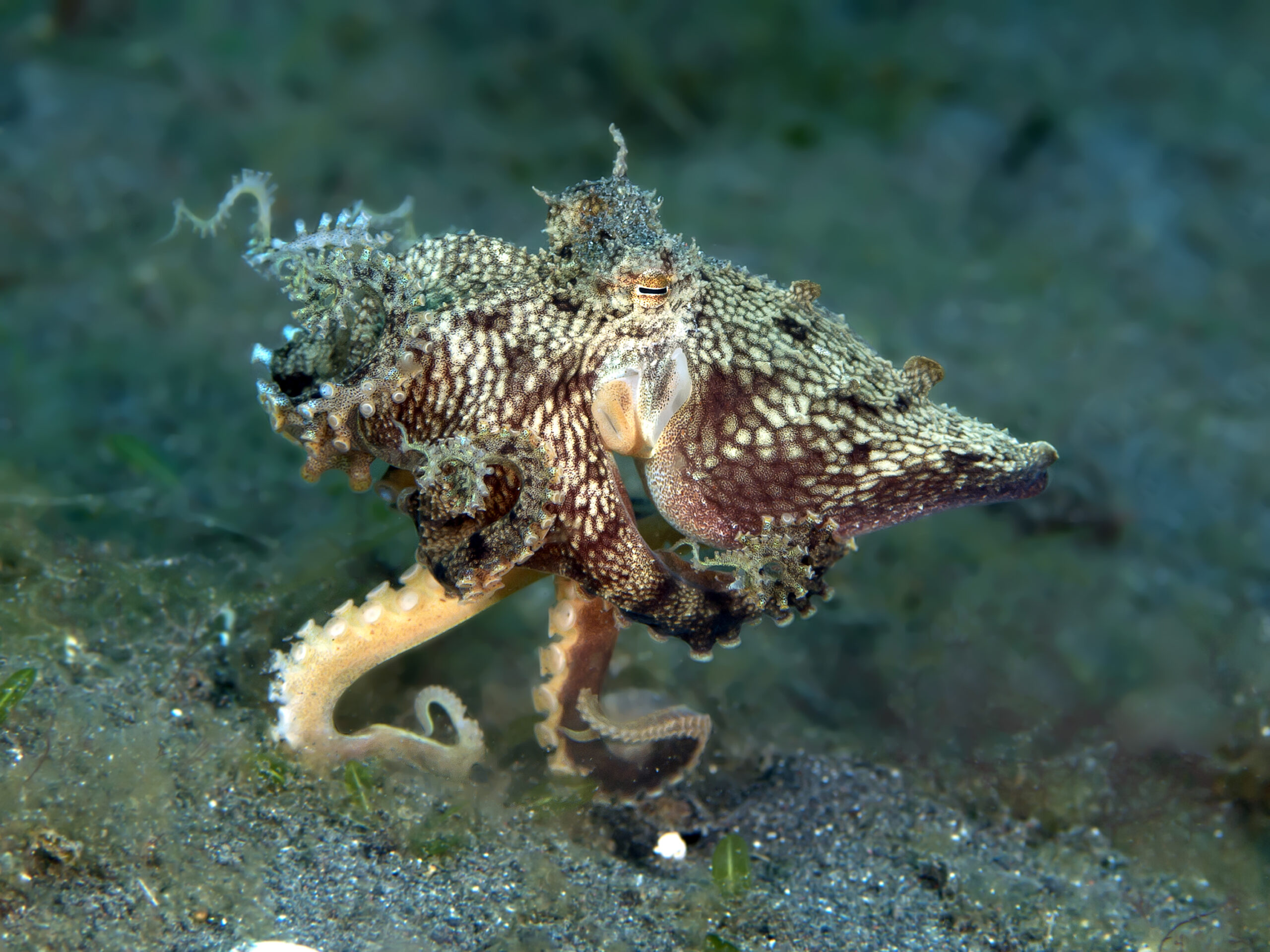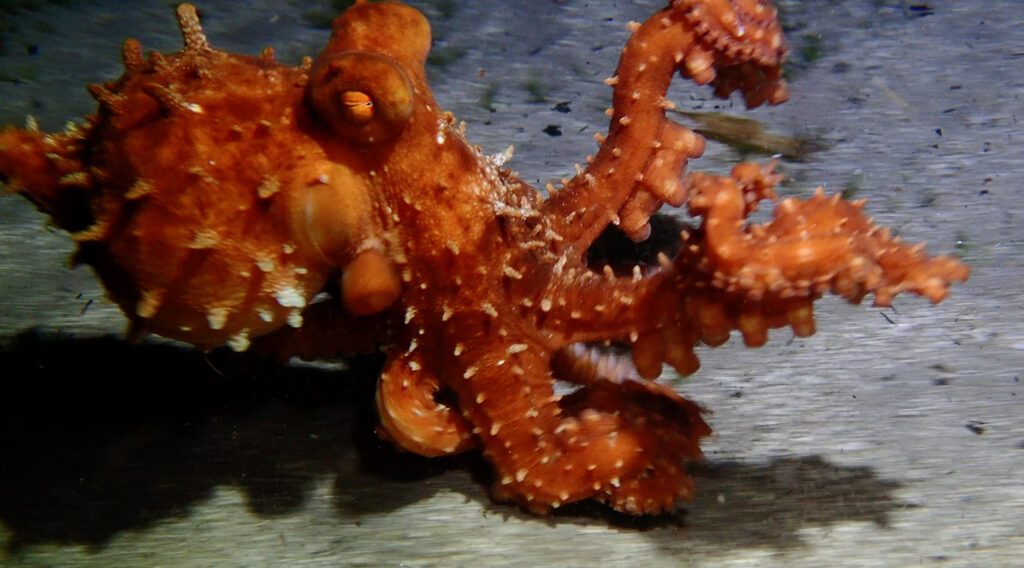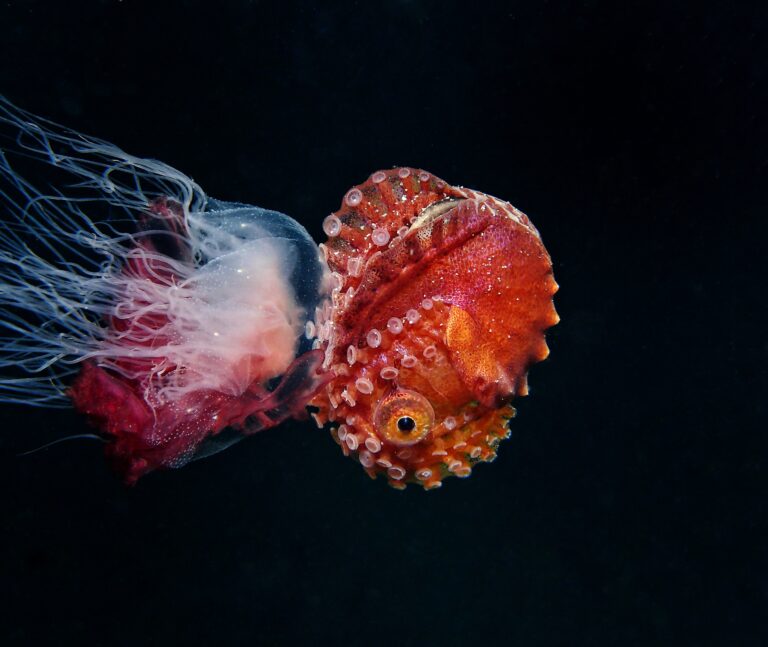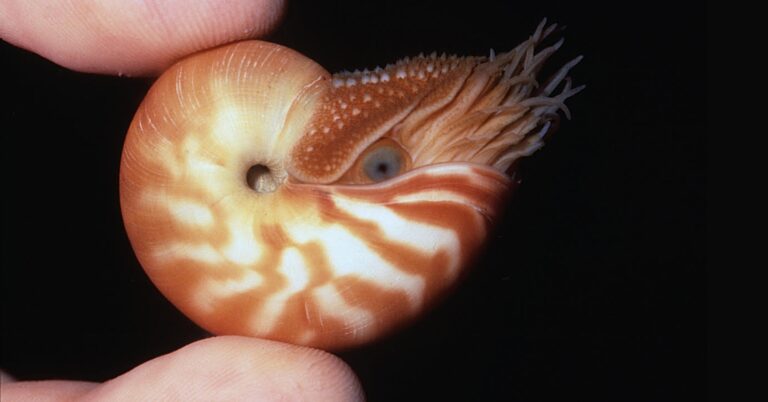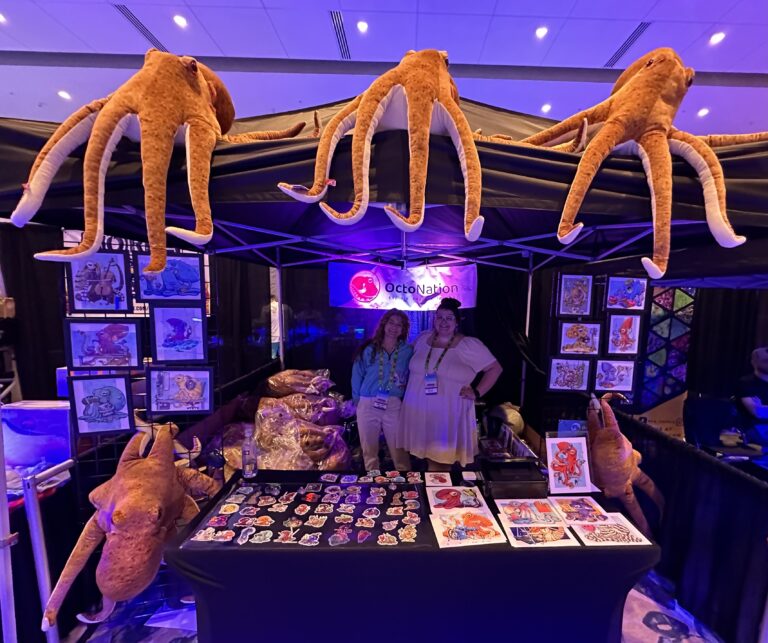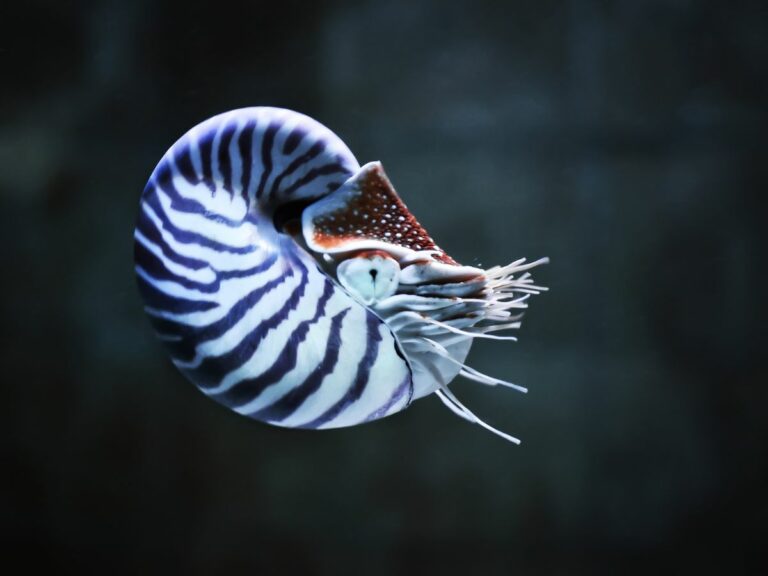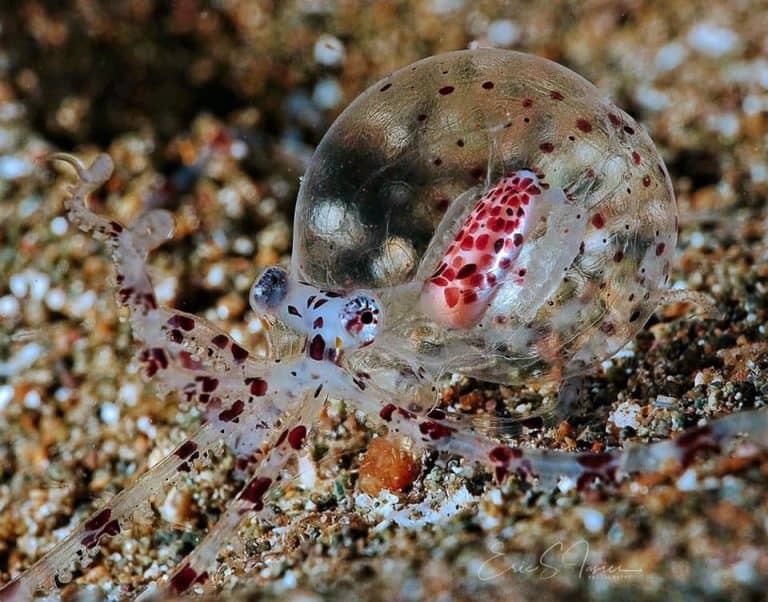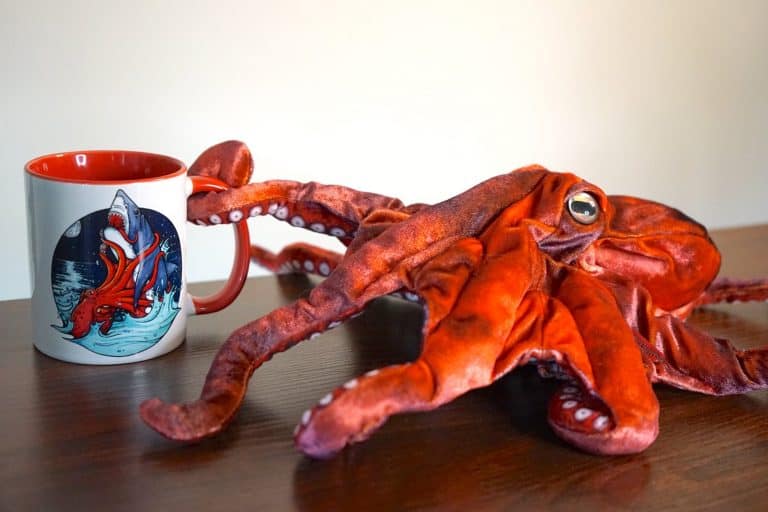Do The (Bipedal) Locomotion! ‘Two-Legged’ Walking In Octopods
Have you ever seen a walking coconut? If you have, chances are it was actually an octopod running on two arms across the sand. This may sound like an odd piece of science fiction or a Saturday morning cartoon, but keep reading, and you will see just how versatile octopod locomotion can be. Get ready to do the (bipedal) locomotion!
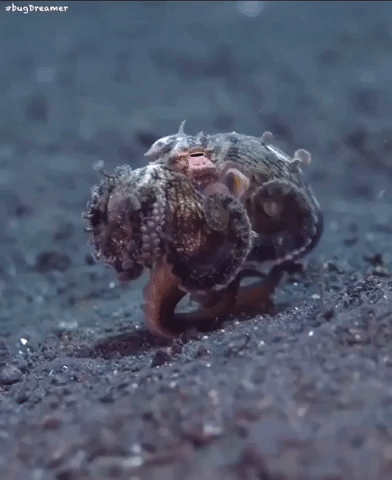
What is bipedal locomotion?
Walking and running on two feet, known as “bipedal locomotion”, is often thought of as a characteristically human or great ape behavior since most amphibians, reptiles, and mammals walk quadrupedally (using four limbs), and many invertebrates use multiple limbs or none at all to locomote.
However, bipedalism is occasionally observed in these other groups. For instance, bears will sometimes rear up on their hind limbs for a variety of reasons, including during fights or attacks, in order to prepare to climb a tree or to get a better view of the landscape.

Bipedalism also occurs in animals you might not expect. The lowly cockroach, which normally scuttles around on six legs, switches to running bipedally when it needs to move at maximum speed since the extra four limbs tend to get in the way and slow it down.
Similar to the cockroach, many lizards can run at much higher speeds on two legs than four. The Common Basilisk Lizard (also known as the Jesus Christ Lizard) even moves so quickly on its two hind legs that it can “run” across the surface of the water!
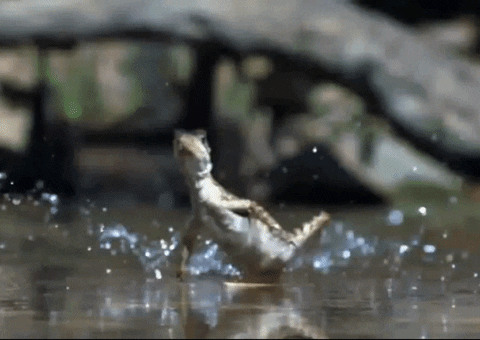
Bipedalism in an octopus
Bipedal locomotion has also been documented in octopods – those wacky, eight-armed mollusks known for their color-changing abilities, regenerating limbs, and surprising smarts.
Bipedal “walking” or “running” has been recorded in four species of octopods so far:
- Australian Algae Octopus (Abdopus aculeatus)
- Indonesian Coconut Octopus (Amphioctopus marginatus)
- Tropical Sand Octopus (Callistoctopus furvus)
- Common Octopus (Octopus vulgaris)
Here, we explore this ability in octopuses, including how and why they do it. But first, a bit of an octopus anatomy lesson is needed.
A tour of the armory: Octopus anatomy 101
Before we start, a clarification: Although often referred to as “tentacles” in conversation and popular media, octopods do not have tentacles at all!
The eight limbs of an octopus are actually referred to as “arms,” a more multi-purpose appendage than a “tentacle,” which specializes in food capture. Octopus relatives– squids and cuttlefish –also have eight arms, as well as two tentacles that can usually be ejected forward rapidly to capture prey.
In addition to a difference in function, the anatomy of these arms and tentacles vary. Octopus arms usually have two or occasionally one row of suckers along their entire length, while tentacles are smooth along most of their length but terminate in a paddle shape with several suckers or hooks to capture prey. This is what various tentacles look like…
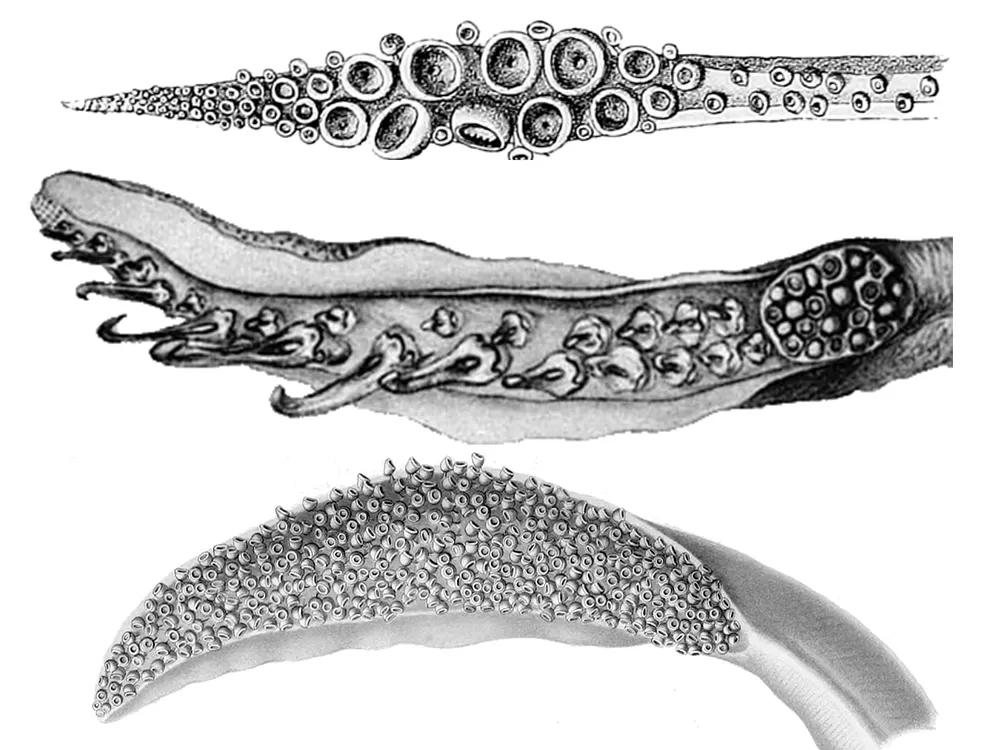
The eight arms of an octopus are used in a wide variety of tasks, including:
- Locomotion
- Investigating their surroundings
- To aid in camouflage or mimicry
- Catch prey and pass it to the mouth
Intriguingly, the arms do not just have the ability to feel an octopod’s surroundings–they can also taste and smell, thanks to dozens to thousands of flexible suckers lined with receptors like taste buds!
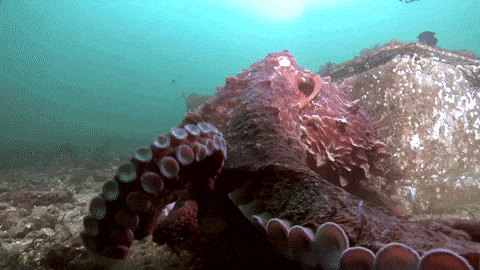
These sensory abilities help octopods navigate in their environment, identify mates and flush out hidden prey. Individual octopuses often favor particular arms for certain tasks, much the same way humans are usually right- or left-handed for writing and throwing.
To help differentiate between them, researchers refer to the four arms on the left side of the octopus as LI, LII, LIII, and LIV from front to back and RI, RII, RIII, and RIV on the right.
![Diagram of octopod anatomy by T.G. Plein [original art created for this piece]](https://octonation.com/wp-content/uploads/2023/02/octopus-side.jpg)
![Diagram of octopod anatomy by T.G. Plein [original art created for this piece]](https://octonation.com/wp-content/uploads/2023/02/octopus-top.jpg)
…and I would walk 500 (nautical) miles…: Why an octopus walks bipedally
When they move around, many species of octopods change their color and texture in order to blend into their surroundings or disrupt their telltale outline as they pass over different types of seafloor, such as sand, coral, or rock.
To prevent their motion from giving their presence away, they will also often move at a measured pace, taking their time and avoiding sudden movements that might attract a predator’s attention.
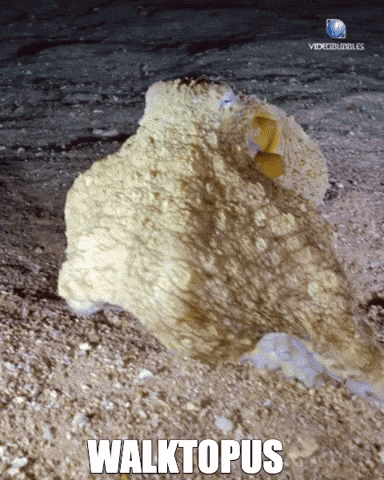
Octopus cyanea, the Day Octopus, for example, spreads its webbed arms, creeps slowly, and changes its body pattern in order to appear to be a moving rock!
Jet propulsion
But sometimes octopods need something quicker. For instance, to escape an attack, an octopus may “jet” away by blowing water out of the siphon, propelling its body rapidly in the opposite direction, often expelling ink as it flees.
Mimicry
There are also times when they need to move quickly but still want to remain disguised. This is where mimicry and masquerade, in which octopods pretend to be something they are not in order to avoid being noticed or recognized by a predator, can come into play.
The aptly named Mimic Octopus is the octopod poster child of this, as it can impersonate several other species, ranging from deadly sea snakes to the prickly and venomous lionfish. This tactic, known as Batesian mimicry, allows the mimic octopus to appear dangerous or inedible to potential predators while not having to go to the trouble of manufacturing sea snake or lionfish venom itself.
Camouflage
But octopods don’t always impersonate something dangerous. Instead, they sometimes opt to masquerade as an organism that is relatively uninteresting to predators, such as a plant or a rock.
By changing their shape, posture, and color pattern, octopods can take on forms that, to an untrained eye, appear to be a rock, seaweed, algae, or even a coconut. This is often when bipedalism occurs!
Using only two of their arms as “legs” to “walk” or “run” allows them to use their remaining arms to craft the perfect disguise, contorting into what appears to be a tumble-weed of algae or tucking them away to imitate the round shape of a coconut.
These postures are often accompanied by color changes that enhance the effect, usually by turning a darker color to match the color of the object that they are imitating.
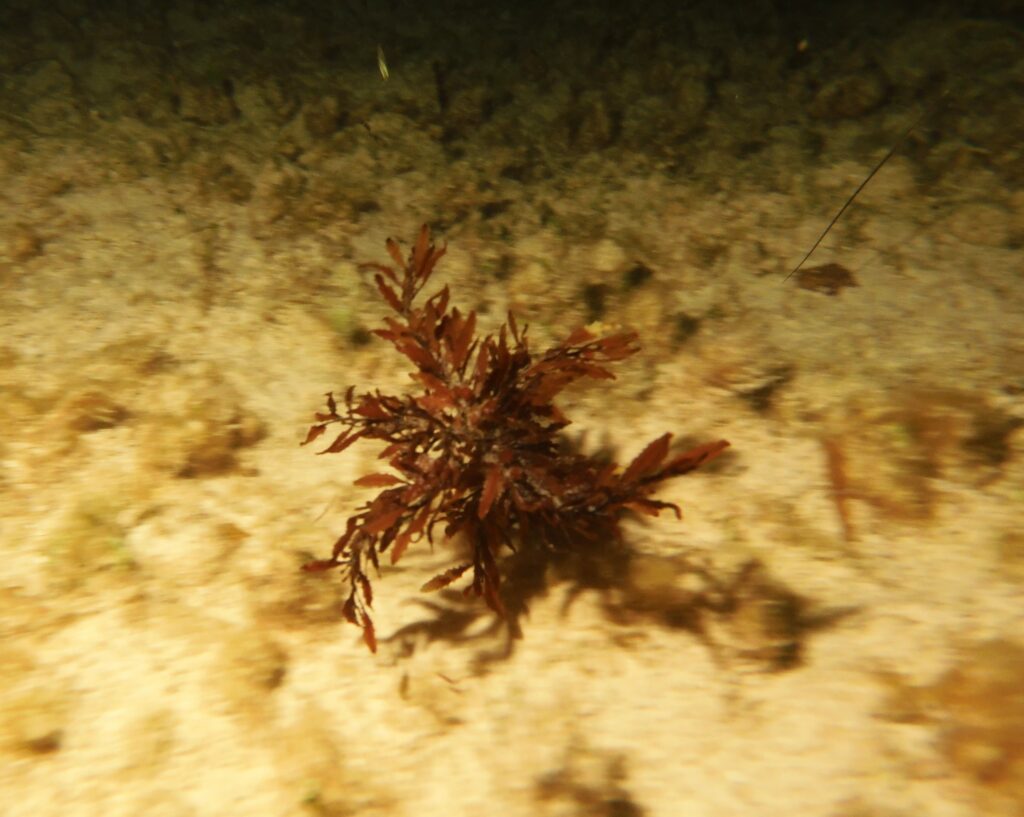
Octopod crypsis: What’s that?
While the effect appears comical to our eyes, all of these contortions and color changes enhance octopod crypsis, which is a fancy word for being sneaky and avoiding detection–an octopod’s primary form of defense.
Walking bipedally helps octopods fool many fish predators into thinking that it is an inedible plant or algae, allowing them to move stealthily across the seafloor without becoming dinner.
Pretty clever for a sea creature!
Octopuses and their flamboyant display
While the Coconut Octopus attempts to resemble a round coconut when moving bipedally, the Sand Octopus, the Algae Octopus, and the Common Octopus utilize the “flamboyant display” during their bipedal locomotion.
In this display, the octopus raises its front arm pair and twists them into a corkscrew shape, extends its mantle papillae, and holds its other arms close to or under its body. These contortions and texture changes, along with color changes, cause the octopus to resemble a piece of floating Sargassum or another seaweed.
The flamboyant display is also seen in many other cephalopods, including cuttlefish and squid, where it can play a role in crypsis or in communication.
Although it does not function exactly the same way in every species, the existence of this display in such distantly-related groups suggests that it is evolutionarily conserved, meaning that it plays an important role in cephalopod survival!
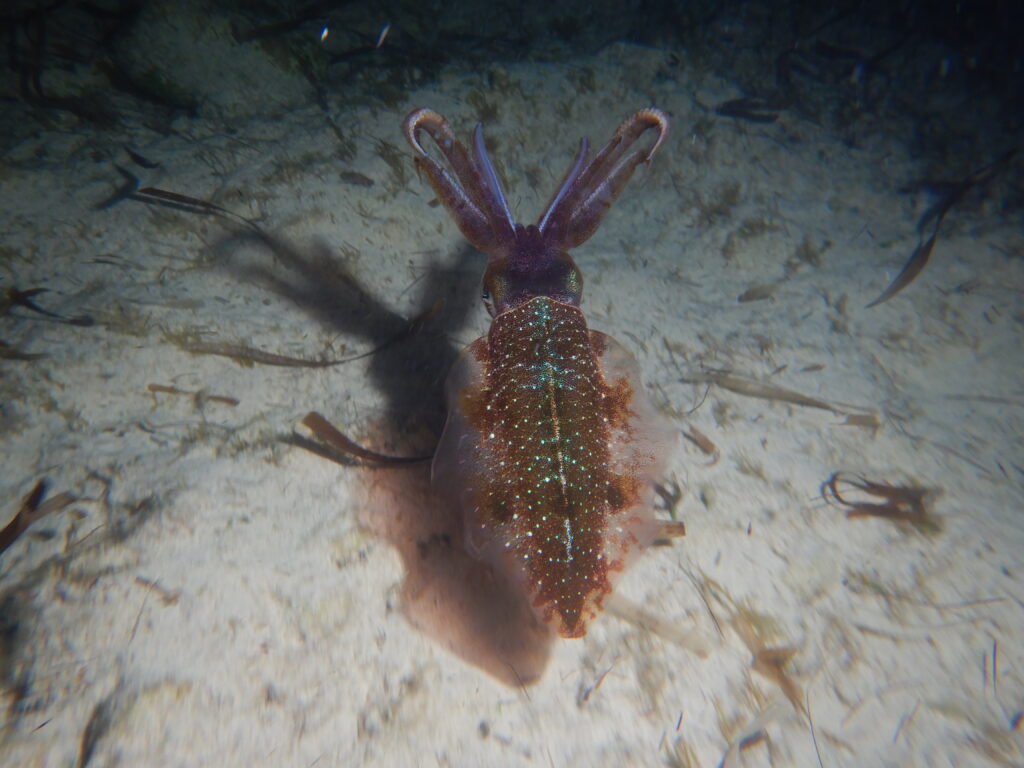
Do octopods’ bodies affect their bipedalism?
Octopods are mollusks, a group characterized by a soft body and a hard outer shell. However, over the course of their evolution, cephalopods lost this protective covering in favor of more sophisticated “squishy” defenses, such as:
- Crypsis
- Enhanced predator detection abilities (sight and “smell”)
- A complex nervous system
Cephalopods do not have the rigid system of either internal or external hard structures (bones or exoskeletons) that we and many other animals use to get around.
In human bodies, our bones work together with our cartilage, muscles, ligaments, and tendons to produce movement. The muscles are attached to the rigid skeleton, which provides anchor points and support against which muscles can push and pull.
Octopods, by contrast, lack this support and instead utilize the pressure created by the fluid-filled tissues inside their bodies to provide support for limb movement.
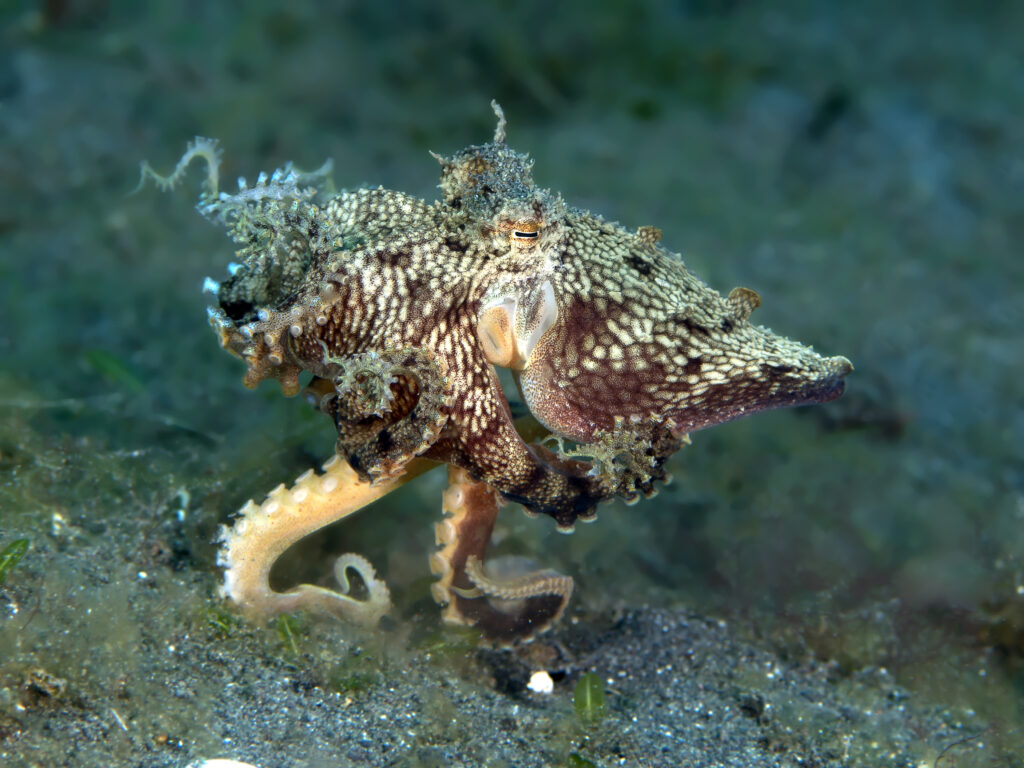
So, octopuses don’t have bones?
Instead of bones or an exoskeleton, octopods are composed almost entirely of soft muscle and tissue.
The muscles of octopus arms are organized into two groups that perform opposing but complementary actions to produce movement. While one group of muscles contracts to provide force, the other group relaxes, causing it to elongate and stretch, thus causing limb extension.
The general lack of hard parts in their bodies allows octopods a wider range of motion than other species, since they are not limited by the range of motion of a joint, but can bend a limb almost anywhere along its length.
Moreover, the lack of hard parts in the octopod body (except the beak) gives them the ability to squeeze through any gap or hole in the substrate that is wider than that beak.
How do octopuses walk bipedally?
So if they don’t have any rigid structures, how do octopods use their limbs to walk or run?
Rather than utilizing bendable limbs with a joint like vertebrates and arthropods do, octopuses use either a smooth continuous rolling motion along the length of two arms or alternate their stiffened arm pair IV.
In the Algae Octopus, Coconut Octopus, and Sand Octopus, bipedal locomotion is achieved by the octopus rolling backward along the rearmost pair of arms (IV), while the Common Octopus “hops” backward on two arms of the same side, such as RIII and RIV or LII and LIII.
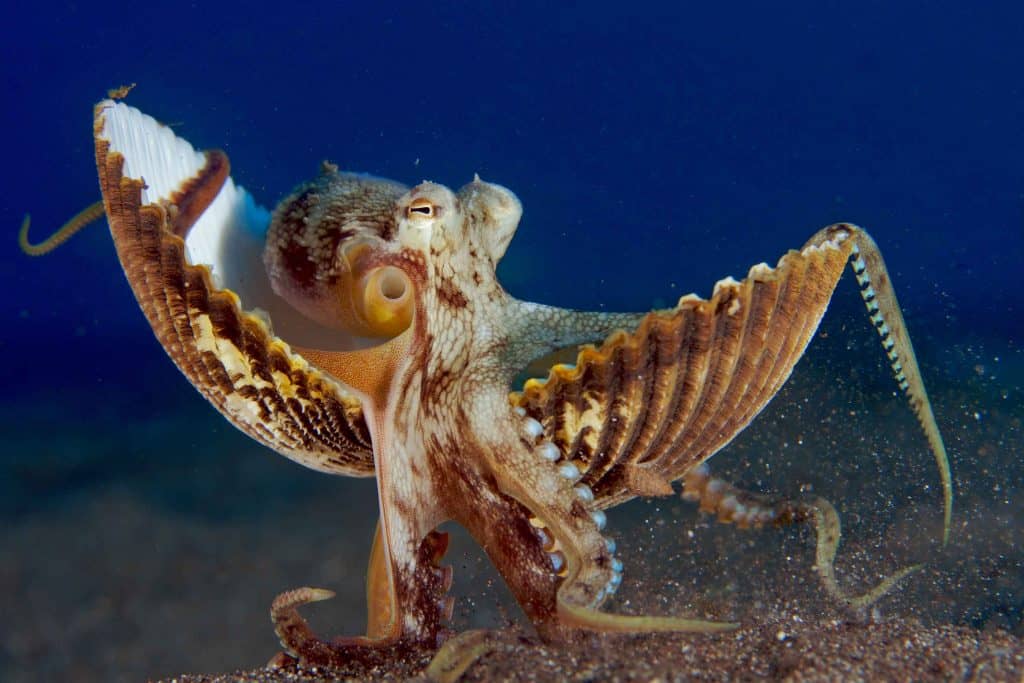
Stepping into the light: Discovering bipedalism in other octopods
Bipedal locomotion has now been documented in four genera of octopods living in three ecologically-distinct regions: the Indo-Pacific, the Mediterranean, and the tropical western Atlantic.
However, bipedalism is likely more widespread among octopods than currently recognized.
More observations of octopod behavior in the wild are needed, especially as new species of octopods are discovered or reclassified every year (currently around 300 species). Formal research is critical to this effort, but so is “community-” or “citizen science.”
Anyone living in proximity to an ocean can grab their mask, fins, and camera and non-invasively (no touching!) document cephalopods or other marine animals in their native habitats, no credentials needed.
In worldwide forums like Octonation, scientists may recognize a species or behavior unknown to science.
So get out there and explore! Who knows, you may even go viral with the next cool octopus discovery.
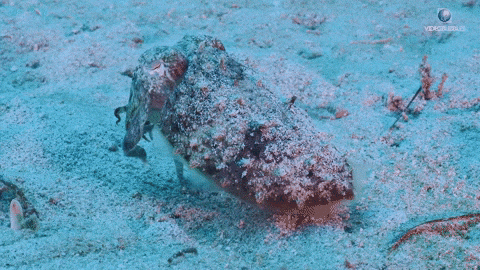
If you want to educate yourself some more about all sorts of different cephalopods, take a look at our encyclopedia. Or, what we call it, our Octopedia!
Connect with other octopus lovers via the OctoNation Facebook group, OctopusFanClub.com! Make sure to follow us on Facebook and Instagram to keep up to date with the conservation, education, and ongoing research of cephalopods.
References:
- AMODIO, P., JOSEF, N., SHASHAR, N. & FIORITO, G. 2021. Bipedal locomotion in Octopus vulgaris : a complementary observation and some preliminary considerations. Ecology and Evolution, 11: 3679–3684.
- AVENDAÑO, O., ROURA, Á., CEDILLO-ROBLES, C.E., GONZÁLEZ, Á.F., RODRÍGUEZ-CANUL, R., VELÁZQUEZ-ABUNADER, I. & GUERRA, Á. 2020. Octopus americanus: a cryptic species of the O. vulgaris species complex redescribed from the Caribbean. Aquatic Ecology, 54: 909–925.
- GUERRERO-KOMMRITZ, J. & RODRIGUEZ-BERMUDEZ, A. 2019. Soft-bottom octopods (Cephalopoda: Octopodidae) of the southern Caribbean with the description of a new species of Mactrotritopus. Ma- rine Biodiversity, 49: 1197–1215.
- HANLON, R.T. & MESSENGER, J.B. 2018. Cephalopod behaviour. Cambridge University Press, Cambridge.
- HANLON, R.T., FORSYTHE, J.W., JONESCHILD, D.E. 1999.Crypsis, conspicuousness, mimicry, and polyphenism as antipredator defenses of foraging octopuses on Indo-Pacific coral reefs, with a method of quantifying crypsis from video tapes. Biological Journal of the Linnean Society, 66: 1-22.
- HERNÁNDEZ-URCERA, J., GARCI, M.E. & CABANELLAS- REBOREDO, M. 2020. Bipedal locomotion by Octopus vulgaris. Marine Biodiversity , 50 : 87.
- HUFFARD, C.L. 2005. The behavioral ecology and locomotion of Abdopus aculeatus (d’Orbigny 1834). University of California, Berkeley.
- HUFFARD, C.L. 2006. Locomotion by Abdopus aculeatus (Cephalopoda: Octopodidae): walking the line between primary and secondary defenses. Journal of Experimental Biology, 209: 3697–3707.
- HUFFARD, C.L., BONEKA, F. & FULL, R.J. 2005. Underwater bipedal locomotion by octopuses in disguise. Science, 307: 1927.
- JEREB, P., ROPER, C.F.E., NORMAN, M.D. & FINN, J.K., FAO FISHFINDER (PROGRAMME) & FOOD AND AGRICULTURE ORGANIZATION OF THE UNITED NATIONS. 2010. Cephalopods of the World—an annotated and illustrated catalogue of cephalopod species known to date. Volume 3. Octopods and Vampire Squids. Food and Agriculture Organization of the United Nations, Rome.
- JESUS, M.D., SALES, J.B. de L., MARTINS, R.S., READY, J.S., COSTA, T.A.S., ABLETT, J.D. & SCHIAVETTI, A. 2021. Traditional knowledge aids description when resolving the taxonomic status of unsettled species using classical and molecular taxonomy: the case of the shallow water octopus Callistoctopus furvus (Gould, 1852) from the western Atlantic Ocean. Frontiers in Marine Science, 7: 1085.
- Lee, H.J., Lee, Y.N., Fiorillo, A.R., & Lu, J. 2018. Lizards ran bipedally 110 million years ago. Sci Rep 8, 2617.
- O’Brien, S. L., & O’Brien, C.E. 2022. First record of bipedal locomotion in Callistoctopus furvus. Journal of Molluscan Studies, 88 (3).
- PACKARD, A. & SANDERS, G.D. 1969. What the octopus shows to the world. Endeavour, 28: 92–99.
- PACKARD, A. & SANDERS, G.D. 1971. Body patterns of Octopus vulgaris and maturation of the response to disturbance. Animal Behaviour, 19: 780–790.
- THOMSON, T. J. 2019. Three-Legged Locomotion and the Constraints on Limb Number: Why Tripeds Don’t Have a Leg to Stand On. Wiley Online Library, 41.
Written by: Sydney L. O’Brien and C. E. O’Brien
The School for Field Studies
Center for Marine Resource Studies
South Caicos, The Turks, and Caicos Islands
